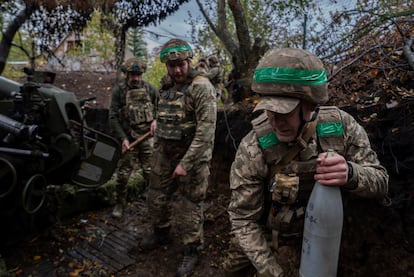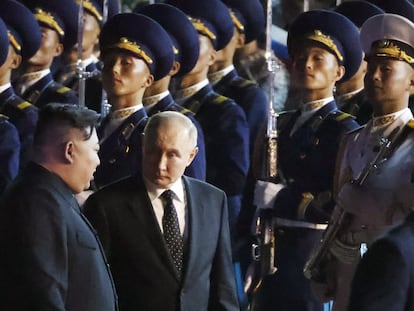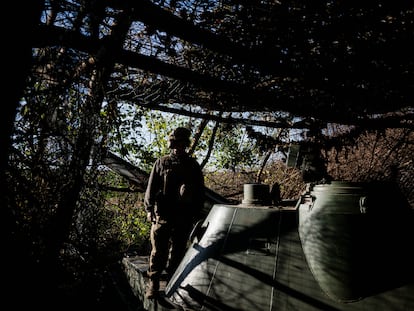Ukraine does not have enough soldiers to stop Russia
Ukrainian military personnel on the Kurakhove front report that troop numbers have been drastically reduced — a setback more severe than the pressing need for additional weapons


Kurakhove is just another name in the Ukrainian province of Donetsk, a region besieged by Russian forces. Nearby municipalities like Pokrovsk, Toretsk, Chasiv Yar, and Kurakhove itself are surrounded from the north, south, and east, complicating the Ukrainian army’s defensive efforts and forcing them to retreat to avoid encirclement. This was the fate met by the Ukrainian cities of Avdiivka and Vuhledar earlier this year. “We will probably soon see Kurakhove follow the same fate, besieged by the Russians,” warns Eugene Churbanov, deputy intelligence commander of the 46th Airborne Brigade and a military veteran decorated with the highest honors of the Ukrainian state.
According to Churbanov, the biggest challenge for the Ukrainian Armed Forces in Kurakhove isn’t Russian military superiority or a lack of weapons; it’s the shortage of soldiers in his regiment that has enabled the recent, relentless Russian advances. Soldiers from four brigades defending Kurakhove share the same grim assessment during the three days that EL PAÍS traveled through this sector of the front. They believe the war’s future looks bleak due to insufficient replacements. “Why are we retreating? Because we have no rotations, we don’t rest, and we are demoralized,” explains Shkoda, the code name of an officer from an anti-drone unit in the 46th Brigade.
This soldier, like others interviewed last week in this conflict zone, is referring to the growing problem of army deserters. The Ukrainian Attorney General’s Office reported that there have been nearly 100,000 desertions since the start of the war, with more than half occurring this year alone. This represents about 10% of all personnel in the Ukrainian Armed Forces. “I had a friend we called England. He fought throughout the war along the front lines — in Robotine, Soledar, Kherson... He was exhausted, unable to continue, and the commanders didn’t give him with a break. A few days ago, he just left, like that.”
Alexander, an officer in the 119th Brigade of the Territorial Defense Forces (TRO), reveals that there was a mass rebellion in Kurakhove involving the 116th TRO Brigade, which refused to follow orders and was subsequently transferred to Sumi, where operations for the Ukrainian incursion into the Russian province of Kursk were being directed. Additionally, a high-profile incident involved 100 soldiers from the 123rd TRO Brigade abandoning their positions in Vugledar just days before it was occupied by Russian forces in early October. These soldiers took this drastic step to protest against being assigned to a seemingly suicidal defense without adequate training and weaponry.
Outnumbered three to one
Churbanov, a sergeant who has been wounded seven times in the war, explains that, by law, he has the right to leave the army. However, he chooses to stay because of the severe shortage of soldiers. He shares a harrowing statistic: his men are currently expected to hold their positions for three months without a break or rotation, whereas a year ago, the maximum was just one month. In the war’s first year, basic rotations occurred every four days.
According to the soldiers interviewed, the average time spent in positions in Kurakhove is around 25 days. Bison, a fighter from the 119th Brigade, estimates that the Russian soldiers outnumber them three to one. “Thank God they don’t have precise information about how dire our situation is in certain areas,” he says. Churbanov adds that the Russians are also “better equipped, better trained, and better adapted to this war than they were before.”
Dimson is the code name of a private infantryman who prefers to keep his brigade affiliation private. He has just returned from a two-day leave, which was supposed to be longer, but he was ordered back immediately after the enemy took the position his platoon was defending, resulting in the capture of several comrades. He silently scrolls through photos of these friends on his phone, seemingly bracing for the worst.
He then shows a video that surfaced online on Sunday, featuring a soldier from a civilian recruitment patrol in Zaporizhzhia firing into the air to disperse a group trying to prevent a young man from being forcibly conscripted into the army. “For every kid they recruit like this, they lose 40 who might have considered joining the ranks,” says Dimson.
Such videos have proliferated since the new mobilization law came into force in May. While there is no official data on the number of recruits, Roman Kotsenko, a member of the Ukrainian parliament’s defense committee, told The Times on October 3 that the goal is to end 2024 with 200,000 new soldiers. U.S. intelligence sources reported to The Wall Street Journal in September that Ukraine had lost 80,000 soldiers during the war, with an additional 400,000 wounded. Most of those injured are recovering and returning to the front lines.
“Soon there will be no one left to fight”
The meeting with Shkoda takes place in a shop in Ulakle, located six miles from the front lines, where he is purchasing food supplies for the upcoming days. “The mobilization of civilians is going poorly because people are scared,” says Shkoda. “They see that individuals are being forcibly taken from the street and sent to the front with minimal training. I don’t want anyone like that at my side — unmotivated and poorly trained — because my life depends on them.”
Dimson adds that two of his fellow prisoners were inexperienced and had only been at the front for three days. The grim reality of rapid mobilization was highlighted in July with the news of the death of Matisyahu Anton Samborsk, the son of Ukraine’s chief rabbi. Mobilized in May, Samborskii received only one month of training and was killed just three weeks into combat.
EL PAÍS also met with a press team from the Ministry of Defense that was visiting regiments in Ulakly. The head of the mission, who requested anonymity, summarized the situation: “The problem now is not the weapons; it’s the people. Nobody wants to join the army. The brigades tell us that they cannot rotate, that they are exhausted. Soon, there will be no one left to fight.”
Another factor contributing to the less frequent rotations is the pervasive threat of drone bombs, which significantly hinder soldiers’ movements. The journey to Kurakhove itself exemplifies this danger. The invading troops are positioned at the eastern edge of the city, where they relentlessly target the road leading in from free Ukraine.
The soldier at the wheel activates the radio-electronic equipment installed in the all-terrain vehicle, designed to neutralize drone threats by jamming the signal to their operators. Increasingly, vehicles — especially armored ones — are being outfitted with these electronic warfare devices. Oleg, the soldier accompanying this newspaper to Kurakhove, estimates their effectiveness is about 50%. Without such equipment, the chance of survival is drastically reduced. This is illustrated by a vehicle that was destroyed just moments earlier by a drone bomb, now left in the middle of the road as a stark reminder of the risks involved.

Kurakhove is now just another ghost town, its lifeless streets echoing only with the presence of soldiers sheltered in basements. The town lies in wait for the Kremlin’s designs, poised to be razed by artillery and airstrikes before an impending assault. The Ukrainian response could involve defending the area through urban combat, or it may abandon it, like what happened in Avdiivka.
Drone pilots from the 113th Territorial Defense Brigade and Shkoda acknowledge a significant drawback in Ukraine’s reliance on drones for urban defense: these unmanned vehicles are far more challenging to maneuver in densely populated areas compared to open fields.
“If things don’t change significantly,” Churbanov states with a calm, somber tone, his exhaustion evident, “our grandchildren will have to keep fighting too.”
Sign up for our weekly newsletter to get more English-language news coverage from EL PAÍS USA Edition
Tu suscripción se está usando en otro dispositivo
¿Quieres añadir otro usuario a tu suscripción?
Si continúas leyendo en este dispositivo, no se podrá leer en el otro.
FlechaTu suscripción se está usando en otro dispositivo y solo puedes acceder a EL PAÍS desde un dispositivo a la vez.
Si quieres compartir tu cuenta, cambia tu suscripción a la modalidad Premium, así podrás añadir otro usuario. Cada uno accederá con su propia cuenta de email, lo que os permitirá personalizar vuestra experiencia en EL PAÍS.
¿Tienes una suscripción de empresa? Accede aquí para contratar más cuentas.
En el caso de no saber quién está usando tu cuenta, te recomendamos cambiar tu contraseña aquí.
Si decides continuar compartiendo tu cuenta, este mensaje se mostrará en tu dispositivo y en el de la otra persona que está usando tu cuenta de forma indefinida, afectando a tu experiencia de lectura. Puedes consultar aquí los términos y condiciones de la suscripción digital.
More information
Archived In
Últimas noticias
There is as much life left to discover on planet Earth as that which is already known
Dozens presumed dead, around 100 injured in fire at Swiss Alps bar during New Year’s celebration
Is porn for women different from conventional porn? We spoke to those who make it
Cartagena de Indias is sinking: What can the city do to mitigate it?
Most viewed
- Reinhard Genzel, Nobel laureate in physics: ‘One-minute videos will never give you the truth’
- David King, chemist: ‘There are scientists studying how to cool the planet; nobody should stop these experiments from happening’
- Sinaloa Cartel war is taking its toll on Los Chapitos
- Oona Chaplin: ‘I told James Cameron that I was living in a treehouse and starting a permaculture project with a friend’
- The Interoceanic Train, the Mexican alternative to the Panama Canal










































